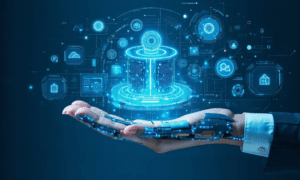In today’s digital age, where efficiency and seconds count, AI transcription services are critical for writing spoken words. These technical wonders promise quick, low-cost solutions to the long-standing demand for precise documentation. As the potential of artificial intelligence rises, so does the argument about impersonal technology vs refined human touch. This article examines the benefits and drawbacks of AI transcription services, with a focus on human interaction. In an automation-driven culture, we investigate how to accept technology while maintaining human values.
Benefits of AI Translation:
Quick and effective
In today’s fast-paced environment, being able to instantly convert audio and video to text is essential. AI transcription systems can handle hours of audio in minutes, whereas humans take far longer. AI’s speed enables it to expand operations, manage massive volumes of data, and meet deadlines, making it critical for a variety of industries, including media and healthcare.
Economy of scale
One of the most appealing aspects of artificial intelligence transcribing is its low cost. Conventional human transcription services can be costly, particularly for large or urgent tasks. However, AI transcription is typically less expensive and does not require a large workforce.
Availability
AI transcription services are more accessible because they are available 24/7 and have less scheduling constraints. Businesses and individuals can avoid the difficulties associated with employing human transcription services by making transcribing services available at all times, from anywhere, and on demand.
Drawbacks of AI Transcription:
A lack of context and subtlety
Artificial intelligence transcribing systems are effective, although accents, dialects, and industry-specific language frequently provide challenges. Transcriptions may be erroneous because AI can not comprehend context as well as humans. This constraint is notably affecting legal and medical transcription, where errors might have devastating consequences.
Error Rate/Reliability Problems
Despite their dependability, AI transcription services sometimes make blunders. Low-quality audio, overlapping speech, and background noise can all degrade accuracy. These error rates necessitate human inspection to assure transcription accuracy, highlighting the significance of human supervision in the transcription process.
Privacy and security concerns.
Transcription services, like many other AI technology, pose issues about data security and privacy. When AI systems handle sensitive data, security issues can arise. Secrecy is especially critical in sectors that handle sensitive data, emphasising the necessity for rigorous security protocols and, in some situations, human transcriptionists to ensure confidentiality.
The Human Value of Touch.
Precision and Context.
Only humans can grasp sophisticated language, such as colloquial idioms, cultural allusions, and industry-specific jargon. Human transcribers can recognise context and subtle signals that AI overlooks, resulting in improved accuracy. This is critical in the legal, medical, and academic realms, where precision is required.
The Quality and Review Process
AI can swiftly generate transcripts, but human review is still required for maximum accuracy. Human transcribers identify and rectify faults that AI may overlook, ensuring that the transcript satisfies industry standards. This review process allows for customer feedback-driven adjustments, ensuring that the final output fits standards.
Privacy and ethics
Human transcriptionists must adhere to confidentiality and ethics. Humans, unlike AI, must adhere to ethical guidelines and non-disclosure agreements to protect private information. This is crucial in corporate, legal, and medical settings where sensitive data must be protected.
Real-world applications and examples
High-Stakes Legal Proceedings
One well-known trial rested on the transcription’s accuracy. The transcriptionist’s ability to comprehend and accurately record legalese, delicate speech, and witness testimony aided the cause. Their knowledge guaranteed that the transcript accurately and reliably described the events, which aided the judges’ decision.
Medical records: timeliness saves lives.
A medical facility reported better patient care after using transcription services with human review. Human transcribers’ meticulous attention to detail and mastery of medical terminology resulted in accurate medical records, reducing patient treatment plan and prescription errors.
Business meetings: Data security
A multinational corporation emphasised secrecy in the transcripts of its worldwide strategy meetings. Human transcribers were constrained by tight confidentiality agreements to protect sensitive content. Their involvement demonstrated the value of individuals in protecting company secrets and provided further data breach protection.
In summary
Transcription services necessitate both human expertise and technological breakthroughs. AI transcription is a vital digital tool due to its speed, utility, and low cost. Language complexities, contextual awareness, accuracy, and confidentiality highlight the unparalleled significance of the human touch.
The examples above demonstrate how human transcriptionists improve transcription quality while also ensuring ethical considerations and the preservation of sensitive material in critical situations. Instead than having to choose between AI and human labour, transcription services’ future rests on combining their best features to develop a hybrid model that maximises productivity and accuracy.
As technology progresses, the emphasis should move to symbiotic AI-human talent exchanges to ensure that transcription services meet and exceed our evolving needs.



































